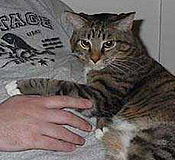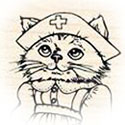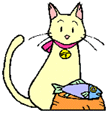Vol. 2, No. 4
Table of Contents
Feline Nutrition: Coming Soon… Best Cat Food!
Assist Feeding: Bert’s PEG Tube Surgery
Kitty Potpourri: Peanut, the Feline Nurse
Caring for Cats: Are We Prepared?
Feline Nutrition – Coming Soon. “Food Of The Week!”
by Garry White
That’s right! Starting next week, the Purrtalk Newsletter will include a brand new article.”Best Cat Food.”
Yeah, yeah…I’ve said many times that I won’t take sides or endorse a particular food, for liability reasons. But I’m just not that strong when it comes to folks asking for help, so liability will have to wait its turn.
There are some ground rules and facts associated with the new article, though, and I encourage everyone to please read them carefully:
Concept: Each week we’ll look at a different food, analyze it to the best of our abilities, give it the final kitty-taste-test, and report our findings to you in our “Best Cat Food ” section.
What prompted this new article? Our goal is to help assure that your kitties get the best nutrition possible, and we know that many of you just don’t have time to do the research.
What kind of foods will be tested? Only those that we consider to be superior: holistic foods, pure foods, foods made with human-grade ingredients… the best cat foods.
Will we test dry and canned? Yes, but not treats.
Will we test alternative-diet foods? No, we won’t look at foods we deem to be non-traditional or radical in nature.
What is the analysis criteria?
- Determine that the manufacturer is serious about quality.
- Assess the contents (to the best of our abilities) to assure a safe nutrient balance.
- Assess not only the ingredients and their proprietary order, but also the source and quality of ingredients.
- Personal trials: When possible, our kitties will get a bite or two, and we’ll share their response with you.
Will we compare foods? No. Each food will be evaluated and rated for its own standing, without regard to any other food.
Important facts:
- We are not veterinary nutritionists, so please understand that our recommendations are based on good intentions, common sense, some serious number-crunching, and personal kitty trials.
- We’ll do our best to have a new food for you every week, but remember that our goal is to present only the best cat food, so in the absence of a suitable delight for a particular week, well, maybe I’ll tell a dirty joke, or something. Did you hear the one about the farmer and the Martian…
I’ll establish the pace early on, but I’d like to get everyone involved with this as quickly as possible, including you! I encourage and invite our readers to take a swing at this ball: If you’ve tried a food that fits our analysis guidelines, and if you’re impressed with it, then we’d love to know about it so we can share it with everyone else. Better yet, write the article yourself (using our format) and it’ll get posted.
In a nutshell: This Best Cat Food article requires extensive research with cat foods. We get requests to share our favorable discoveries, and that’s what the “Best Cat Food” section is all about: presenting a new, quality food each week that we’re comfortable with; cat foods that may help you provide good, safe nutrition for your own kitties. Hope you enjoy it, folks.
Assist Feeding – Bert’s PEG Tube Surgery
by Kathy Fatheree
 Last week… Bert was officially diagnosed with Feline Hepatic Lipidosis (FHL)… or “fatty liver disease.” FHL occurs when the body commands an immediate mobilization of fat stores for emergency energy. These fat stores are released too fast though and the liver becomes literally clogged with fat. The liver can no longer do it’s job to get rid of natural everyday toxins… the toxins build up… kitty feels oh so nauseated… and jaundice will soon set in. If not treated, FHL is 100% fatal…
Last week… Bert was officially diagnosed with Feline Hepatic Lipidosis (FHL)… or “fatty liver disease.” FHL occurs when the body commands an immediate mobilization of fat stores for emergency energy. These fat stores are released too fast though and the liver becomes literally clogged with fat. The liver can no longer do it’s job to get rid of natural everyday toxins… the toxins build up… kitty feels oh so nauseated… and jaundice will soon set in. If not treated, FHL is 100% fatal…
Here’s this week’s Update from Bert’s Mom:
The needle biopsy results confirmed that Bert does have hepatic lipidosis. Dr. S said that the test is accurate enough but if we wanted to 1000% nail it down they could do another biopsy (open surgery this time) and some other expensive types of blood tests. However he feels those are unnecessary at this point and feels confident that it is the fatty liver disease.
NOTE: The open surgery biopsy Dr. S is referring to is obtained by cutting open little Bert’s abdomen to take an actual sliver of his liver. This type of surgery is tough on a weak kitty and if you need to insert a feeding tube anyway, there is no need for the extra trauma. Doing the extra surgery to take a sliver of the liver can sometimes be a life or death decision. cutting open the body and inflicting trauma on the liver can push a weak body over the edge. Be sure to thoroughly discuss the need to do this type of biopsy with a vet specialist.
Bert is scheduled to go in tomorrow at noon to have a PEG tube put in. We are going in at 9:30 to talk with Dr. S about the procedure and have any questions answered. Also we will be visiting with a specialist who is going to walk us through the procedure and the after care; How to feed Bert, how to flush the tube, how to clean the site etc. She also wants to sit down and help us establish a feeding schedule for Bert. She said at first he is going to need to be fed every two hours, a small amount each time. As his body and stomach get more used to the tube and the food we’ll increase the amount of food and decrease the frequency. The specialist said that the tube will be around six inches long and that Bert will have to wear a baby shirt over the tube to keep him (or his siblings) from chewing at it. We went to target and got some shirts and tried them on him tonight. My poor Bert does not like them AT ALL. He walked about two feet and flopped over and refused to get up! It was so funny and so cute but also so stinkin’ sad at the same time!! My poor baby, I’m surprised he hasn’t started to lose his fur from all this stress! It’s just one thing after another. I keep telling myself that the shirt is absolutely harmless. Other than being a new sensation on him it is just fine. It’s big enough so that it’s not obstructing any blood flow but it’ll be snug enough to do its job. He will get used to it.
As far as the surgery goes, they said that it should be relatively short, about a half-hour or so, and that Bert will have to stay for at least one night for recovery. We talked to a wonderful lady named Lalane. She had some of the equipment out that they were going to use in the surgery. She showed us the tube and how they insert it. It was very informative since we had no idea how they did it. They take a long pole with a retractable razor on the end of it and attach the tube with fishing line to it. They put it down his throat (the razor is retractable so it isn’t out at this point) and then once they’re in the stomach they push through the stomach wall and abdomen with the razor. The tube is attached to the tip of the razor with fishing line and so they just pull it straight through. She said that they will be using ketamine and that Bert will be ‘paranoid’ and very, very groggy after the procedure. Depending on how well and how fast he recovers they might keep him over night Thursday as well. Since it’s a very simple procedure they aren’t going to anesthetize him, they are just going to ‘heavily sedate’ him.
Surgery Day
He went into surgery at about noon and did fabulous. It only took about a half-hour and had no complications what so ever. Mitch and I went in to see him at about 4:30 and he was up and walking around. His eyes were not dilated (with the biopsy they were dilated for two days) and he just looked great! He was meowing and laid down on the table and let us pet him for about 40 minutes. He started to get restless so we had them put him back in his cage.
The Day after Surgery
He stayed last night and at midnight they attempted some water. He did awesome with it, no vomiting at all! Today they were going to try his first amounts of food. He will be on CliniCare® liquid diet ($7 bucks a can, one can a day! OUCH!) because it has a lot more vitamins compared to the super watered down A/D. We could do A/D but since the tube is so small we would have to dilute it so much that all Bert would be getting is water with a little bit of food. So his first feeding is going to be at noon and they’re going to call and tell us how it went. If it went good he can come home tonight. If it wasn’t so good he’ll have to stay one more night.
So excellent news so far!
I’ll let you know as soon as we bring Bert home. Lalane called a little while ago to say they were going to attempt the first feeding and to say that Bert was doing great, up and alert! This is the best news we could possibly have!
…Be sure to check in next week to follow Bert’s journey!
Kitty Potpourri – Peanut, the Feline Nurse
by Dan Malenski
This week, my sharp-eyed girls spotted a story that you are not likely to see in your local newspapers and convinced me that it needed to be told. The story is about a tiny cat who benefited from an act of human kindness, and is apparently dedicated to paying it in back in a way in which only she can. You may think that you may need a tissue or two at the start, but put them away, as it is a story that will warm your heart. The story was extracted from an article written by Sarah Baker, a journalist for a publication located in Hardin County, KY.
About a year ago, the hospital staff at Heartland Veterinary Hospital in Elizabethtown, KY took in a scrawny stray cat who found her way to the front door. Her eyes were completely shut from infection and she weighed only three pounds. Although her sight could not be saved, the staff was able to fatten her up to a weight of six pounds, a good weight for her height. Despite her blindness, she had developed an affinity for the surgical patients and had taken the role as a nurse at the hospital. When patients came out of surgery, she would snuggle up next to them or lie on top, and frequently groom them.
KY took in a scrawny stray cat who found her way to the front door. Her eyes were completely shut from infection and she weighed only three pounds. Although her sight could not be saved, the staff was able to fatten her up to a weight of six pounds, a good weight for her height. Despite her blindness, she had developed an affinity for the surgical patients and had taken the role as a nurse at the hospital. When patients came out of surgery, she would snuggle up next to them or lie on top, and frequently groom them.
The cage doors of surgery patients are generally left open because they are examined so often, and the first time that Peanut curled up beside a surgery patient, the staff thought that she was just exploring, but her behavior persisted from patient to patient. If the door of the cage was shut, she would anxiously pace back and forth until someone let her in.
Janet Morris fully realized the extent of Peanut’s nursing powers after her golden retriever, Rajah,  underwent surgery at the hospital. Rajah, who never allowed a cat to get near her, didn’t mind Peanut at all, when she climbed into the cage, lied up against her, and stretched out her tiny arms as if she was hugging her neck. Rajah also seemed to benefit from the soothing sound of Peanut’s purring as she would also lick Rajah’s ears and head and play with her fur.
underwent surgery at the hospital. Rajah, who never allowed a cat to get near her, didn’t mind Peanut at all, when she climbed into the cage, lied up against her, and stretched out her tiny arms as if she was hugging her neck. Rajah also seemed to benefit from the soothing sound of Peanut’s purring as she would also lick Rajah’s ears and head and play with her fur.
“It was just so incredible,” Morris said. “It made all us cry.”
When the painkillers eventually wore off and Rajah was fully awake, she would sniff and rub noses with Peanut, as if to thank her for nursing her back to health.
The little cat overflows with personality and has had so much of an impact on the hospital staff that they all fell in love with her. The hospital staff officially adopted her and gave her the nickname of Peanutter because of her size and her obsession with packing peanuts when not caring for a patient. She will climb in shipping boxes when they arrive, and if the contents are packed in bubble wrap, she will sulk.
The staff’s love for her and the love that she returns had so much of an impact on the hospital staff that in each employee’s car, a picture of Peanut hangs from the rearview mirror, with the words, “It’s all about her”, which reminds the employees that they do their jobs to help all animals just like they helped Peanut. When they adopted Peanut in December 2003, little did they know at the time that that they were taking in a furry little bundle that could best be described as “three pounds of pure love”.
each employee’s car, a picture of Peanut hangs from the rearview mirror, with the words, “It’s all about her”, which reminds the employees that they do their jobs to help all animals just like they helped Peanut. When they adopted Peanut in December 2003, little did they know at the time that that they were taking in a furry little bundle that could best be described as “three pounds of pure love”.
Caring for Cats – Are We Prepared?
by Garry White
We all know that situations arise without regard to our readiness and, as they say.Murphy’s Law will bite us when we least expect it. Oddly, we take steps to protect our own health, our homes, our cars, but we wait for Fluffy to get sick and then we try to respond to it as best we can. I’m not blaming you; this is merely human nature, and we’re all guilty of not worrying about fixing things that don’t seem to be broken.
This article –and the next several– will be a series in which we’ll cover a number of things we can do to stay one step ahead of The Dragon.
And we’ll start slowly.
First of all, it’s important to understand that a good proactive plan has many tentacles. It isn’t just a passing thought or two, or a casual, periodic check of this or that. It is a complex maze of in-roads and out-roads, some minor and some significant, and the reality is that many of us have traveled few –if any– of these twisty highways. That’s my job: Identify the elements of an effective plan, and help you achieve them.
We’ll begin by establishing the necessity. Unlike car insurance, there no laws (other than the laws of common sense) that force you to establish and maintain a good proactive plan for your pets. However, not unlike health insurance, it should be seen as an absolute necessity. Not as an option, not something we’ll get around to one of these days, but something we should move to a front burner and stir until done.
The human factor.forests and trees. Take this saw and go cut down the whole forest.by lunchtime. Learn to fly commercial jetliners today. Such idiotic demands are a certain pathway to failure, and the philosophy is the same concerning an effective, long-term proactive pet care program. There’s much to learn about brand new issues, things to re-discover, routines to settle into, and if we try to do this all at once, we’ll fail. Many years ago, I taught computer science and mathematics at college level, and I learned quickly to make it easy, make it fun, or get used to handing out failing grades.
Same with you and I and this business of developing a proactive plan: We need to make it as effortless as we possibly can, without compromising our goal.
Next week we’ll start with a categorized agenda.an index, of sorts.of the topics we’ll be covering, and what we plan to achieve with each one. Your homework for the week is two tasks: One, commit your brain to the fact that we are going to do this; it’s a necessity, and we want to be prepared for any crisis. Two, obtain a 3-ring binder with pouches inside the front & back covers. A used one will do just fine, but make sure it’s the 2″ kind, not the real skinny ones.we’ll have lots of stuff to put in there before we’re done. Have a good week, and know that this is a good thing to do for your kitty.
Disclaimer: Kathy Fatheree is not at all a medical expert. Contents of this web site are a collection of Kathy’s assist feeding experiences as well as the experiences of other cat owners who have assist fed their cats. While every effort has been made to ensure the accuracy of the information, Kathy Fatheree or anyone associated with this web site cannot be held responsible for anything that may happen as a result of using the information on this site.
